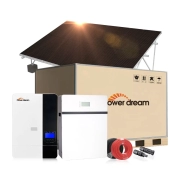What performance metrics should users monitor in a Solar energy storage solution?
With the popularity of solar energy storage solutions, many home users in North America, South America, Southeast Asia, and other regions rely on energy storage solutions to balance supply and demand, stabilize grid fluctuations, and provide backup power during power outages. However, to ensure that these systems operate at peak efficiency, we must monitor several performance indicators. This article will explore the performance indicators that users should monitor in solar energy storage solutions and provide monitoring guidelines for key parameters such as charge state, round-trip efficiency, battery capacity, decay rate, temperature control, and charge and discharge cycles. A well-monitored solar energy storage solution can maximize return on investment and ensure long-term reliability.
Energy Storage Efficiency in Solar Energy Storage Solutions
Energy storage efficiency measures the efficiency of solar energy storage solutions in storing and delivering energy. This indicator compares energy input (from solar panels) to available output and considers losses during charging, storage, and discharge. High efficiency (typically 85-95% for lithium-ion systems) ensures that more stored sunlight can power your home or business. For example, a system with an efficiency of 90% converts 9 kWh of electricity into usable electricity for every 10 kWh of electricity generated. BARANA’s solutions all feature a battery management system that optimizes energy storage efficiency by automatically adjusting the charge rate to minimize losses. Users should monitor efficiency monthly through the system dashboard, checking for efficiency drops that could indicate component aging or calibration issues.

Monitor State of Charge and Depth of Discharge
One key performance metric to monitor in a solar energy storage solution is the state of charge, which refers to the amount of charge remaining in the battery. Accurately measuring the state of charge optimizes energy use and extends battery life. Equally important is monitoring the depth of discharge, which reflects the amount of power used relative to the total available capacity. A higher DoD causes the battery to degrade faster, so keeping it within recommended limits is critical.
Advanced sensors and battery management systems are used in solar energy storage solutions to provide accurate SoC readings and properly manage DoD. The BMS continuously tracks voltage, current, and temperature data estimates SoC in real-time, and adjusts the charging program accordingly. For example, if the SoC falls below a certain threshold, the system may initiate a fast charge mode to ensure a balanced energy supply. This dynamic adjustment prevents over-discharge and maximizes energy efficiency by optimally cycling the battery.

Evaluate round-trip efficiency and Energy Losses
Round trip efficiency in a solar energy storage solution calculates the total energy lost during storage and retrieval. If a solar energy storage solution stores 10 kWh but outputs 8.5 kWh, an 85% round trip efficiency means 15% energy loss. In reality, the efficiency of a solar energy storage solution is affected by many factors, including the quality of the battery cells, the performance of the inverter, and the efficiency of the charge controller. Losses can occur at various stages; for example, during the DC-to-DC conversion process of the solar panel, during the charging and discharging process inside the battery, and finally, during the conversion back to AC when needed. BARANA’s solar energy storage solutions can achieve 85% to 95% round-trip efficiencies using hybrid inverters.
Tracking Battery Health and Degradation Rates
All batteries in a solar energy storage solution, known as performance degradation, will degrade over time. Therefore, key indicators include capacity retention, internal resistance, and the number of charge and discharge cycles completed. As batteries age, their ability to hold a charge decreases, and their internal resistance increases, which results in reduced energy efficiency and power output. State of health indicators provided by battery management systems allow users to track the degradation of battery cells in real-time. These systems combine voltage, current, and temperature data to assess the battery’s overall health and predict its remaining useful life.

The Role of Temperature Management in Solar Energy Storage Solutions
Temperature is a critical factor affecting the performance and life of any battery system in a solar energy storage solution. Solar energy storage solutions lose 2-3% efficiency for every 10°F (3°C) increase above 77°F (25°C). Batteries are susceptible to temperature fluctuations; excessive heat accelerates chemical degradation, while extreme cold reduces the battery’s ability to deliver power. Therefore, monitoring and optimizing temperature control and thermal management are critical to ensure efficient system performance.
BARANA’s liquid-cooled batteries maintain an optimal temperature range of 59-95°F (15-35°C), in addition to a thermal management system that actively monitors battery temperature and adjusts cooling or heating elements as needed. For example, integrated temperature sensors deliver real-time data to the control system, enabling dynamic adjustments to keep the battery within its optimal operating range.
Best Practices for Monitoring and Optimizing Performance
Carefully observing the state of charge, round-trip efficiency, battery health, temperature control, and charge and discharge cycles in monitoring solar energy storage solutions can give you insight into system performance and address potential issues in advance. By leveraging battery management systems, integrated monitoring tools, and proactive maintenance strategies, you can ensure that every aspect of your energy storage solution operates at its best.





